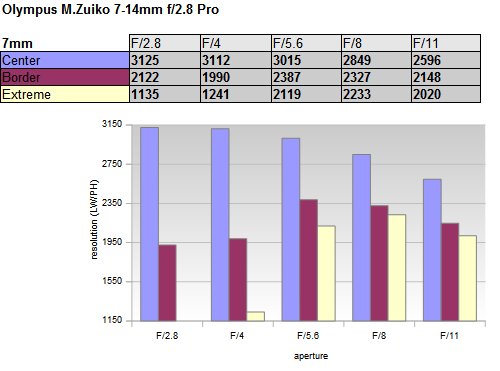|
Olympus M.Zuiko Digital 7-14mm f/2.8 PRO - Review / Test Report - Analysis |
|
Lens Reviews -
(Micro-)Four-Thirds
|
|
Page 2 of 3

Distortion
The Micro-Four-Third system uses an automatic distortion-correction thus from a user perspective, this is little to worry about. Images only show a very moderate barrel distortion a 7mm and there's little to report beyond.
While most RAW converter as well as the camera (JPEGs) don't give you a choice, a few still do (e.g Capture One) thus it is possible to verify the original characteristic of the lens. With disabled auto-correction, the Olympus lens shows a 7.2% barrel distortion at 7mm. This is nothing short of excessive really and clearly a sign that the lens was purposely under-designed to save costs and/or reduce the size/weight. The 10mm setting is much better but the barrel distortion is still very noticeable at 2.8% whereas the 14mm setting is pretty much perfectly corrected.
Vignetting
Auto-correction is also applied to the vignetting characteristic. The systems shows a very mild light falloff of around 0.5 EV (f-stops) at all setting except at 7mm f/2.8 where the issue is marginally more pronounced.
 Surprisingly we didn't find massively worse figures when looking at the RAW data. It suggests 0.5EV more at 7mm which is a suspicious actually - typically the difference is more pronounced.
Surprisingly we didn't find massively worse figures when looking at the RAW data. It suggests 0.5EV more at 7mm which is a suspicious actually - typically the difference is more pronounced.
MTF (resolution)
The Olympus M.Zuiko 7-14mm f/2.8 Pro is a bit of a complex being with respect to its resolution characteristic. On the focus "plane" the results are quite impressive ... if we ignore that the plane is heavily curved at wide-end - more on this in the next chapter. The center quality is nothing short of outstanding. At large apertures it is a pretty sure bet that the lens is capable of outperforming the 16mp sensor used for testing. The corners/borders aren't quite there but they are still good to very good. Due to the comparatively small sensor you can immediately spot diffraction effects that start beyond f/2.8. While this has little relevance till, f/8 you should avoid f/11. The overall characteristic remains intact at 10mm. The outer image region improves a bit at 14mm.
The tested sample had a good centering quality.
Please note that the MTF results are not directly comparable across the different systems!
Below is a simplified summary of the formal findings. The chart shows line widths per picture height (LW/PH) which can be taken as a measure for sharpness.
If you want to know more about the MTF50 figures you may check out the corresponding Imatest Explanations

Field Curvature (7mm)
Testing the effects of field curvature is notoriously unreliable so take the following with a grain of salt. In the previous chapter we illustrated the MTFs when following the field curvature across the image field. In this chapter we analyse the flat field reproduction at 7mm. The field curvature is, of course, most obvious at fully open aperture - essentially we are documenting the related local out-of-focus effects here. The center quality remains identical, of course, but the corner quality falls completely apart at f/2.8 and f/4. The increased depth-of-field catches up at f/5.6 although the max MTFs on the actual focus field cannot be reached even at f/8.
Now what does this mean in the real life rather than in the lab ? For best performance (edge to edge sharpness in an "infinity" scene) you should stop down to f/8 and pull the focus slightly towards you (towards closer focus distance). This will pull the corners into focus.

Chromatic Aberrations (CAs)
In practical terms the lateral CAs (color shadows at harsh contrast transitions) are visually irrelevant.

|